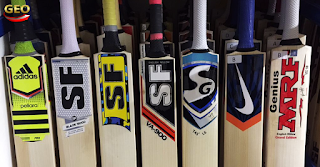About English Willow Cricket Bat
In a game of Cricket, whether your main job in the
side is to bat, bowl, or keep wickets you’re going to need a Cricket Bat. CricketBat The bat consists of two parts, a handle and a blade. The bat overall shall
not be more than 38 inches/96.5cm in length. The blade of the bat shall be made
solely of wood and shall not exceed 41⁄4 in/10.8cm at the widest part.
One end of the handle is inserted into a recess in
the blade as a means of joining the handle and the blade. The part of the
handle that is then wholly outside the blade is defined to be the upper portion
of the handle. It is a straight shaft for holding the bat. The remainder of the
handle is its lower portion used purely for joining the blade and the handle
together. The handle is to be made principally of cane and/or wood, glued where
necessary and bound with twine along the upper portion. The upper portion may
be covered with materials solely to provide a surface suitable for gripping.
Such covering is an addition and is not part of the bat.
Cricket bats are made from Willow. This wood has the
characteristics of being hard wearing, relatively light, and easy to sand and carve
into shape. The willow used in Cricket bat manufacture hails from two main
areas i.e., England and Kashmir. The former is the traditional home of bat
manufacture and the willow from England is often given a high star rating. All
International & First class Players are using only English Willow Bats as
these bats provide maximum punch and impact to the ball.
No two bats will feel exactly the same in your
hands, even if they are of the same weight and handle length. Each piece of
wood used in bat manufacture is unique. The lighter the bat, the quicker you
should be able to maneuver it in the air. On the other hand, the heavier a bat,
the more impact it may have on the Cricket ball. Most hard-hitting, powerful batsmen
tend to use heavy bats.
Most important aspect of EnglishWillow Bat is its Pick up and Balance. How a bat feels in your
hands when lifting it off the ground is known as the “Pick Up of the Bat”.
Generally, international batsmen prefer bats to have a lighter pick up but
still be weighty enough to give the ball a frightful tonk.
You need to consider three important points when
making your English Willow bat selection:
1.
Weight of the bat - The weight can vary from just
over 1000 grams to 1400 grams. It may not sound like much of a difference.
2.
Length of the bat handle - Bat manufacturers offer 2
types of handle sizes i.e., Short and Long. Which type you go for depends upon
your grip on the bat and the size of your hands. If you have great big hands
and space them out on the handle when gripping it, you need a long handle. If
you have dainty little paws and eave relatively little room on the handle, a
short handle may be for you. Have a look both sizes & you’ll soon feel
which one is right for you.
3.
Size of the Bat – Cricket Bats comes in various
sizes ranging from 1 to Full Size. Full sized Cricket bats are too big for
junior and for short players. You can select your bat size based on your height
and age. For younger children bats sizes starts from Size 1 and go upto Size 6.
Special size for youth also exists and referred as “Harrow Size” which is just
a touch smaller then full size.
Cricket ball is a very hard object, particularly
when propelled at around 150 Kmph. English Willow Bats have to go through a process of preparation before
they are ready to be hit at high speed by a Cricket ball. Proper bat
preparation includes:
Ø
Oiling with linseed oil - The oil protects the wood.
You should apply three coats of oil to the front of the bat, leaving it to dry
properly each time you apply fresh oil.
Ø
Hitting the bat with force - You have to get the
wood used to the impact of a Cricket ball. Therefore you should spend several
hours hitting it with a bat mallet. This process is called “Knocking In” and is
extremely essential, otherwise you’ll find the bat cracks or shatters when you
finally use it in a match. Knock the bat in gently at first and then gradually
build up the force that you use.
Ø
Sometimes you’ll see that a manufacturer sells a bat
as ready to play. This means that a machine has been used to knock the bat in
and that a plastic protective facing has been fitted to the front of the bat.
Generally, these bats must also undergo knocking in, and particularly along the
edges.
Toe Guards - This is a piece of rubber or plastic
fitted over the bottom called the Toe of the bat. Some new bats have “Toe
Guard” fitted. The idea is to prevent cracking at the toe of the bat, which is
quite common. If your bat doesn’t have a toe guard consider getting one fitted. 


At Western Sports Centre we have a specialist Cricket Bat repair and restoration service centre helping you salvage your favourite cricket bats. No job is big or small so why don't you contact our specialists and get that repair done as soon as possible as once crack appears, it will continue to get worse, and eventually the bat will have to be replaced.Junior Cricket Bat in Melbourne |Cricket Bat in Melbourne |Junior Cricket Bat in Melbourne
ReplyDelete